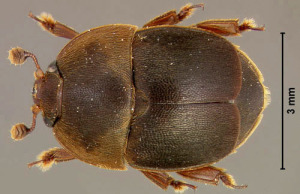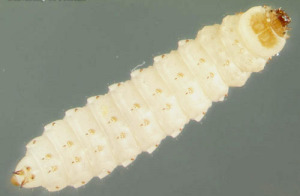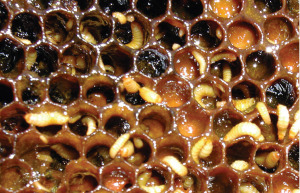Small Hive Beetles
Aethina tumida
Description
A native of Sub-Saharan Africa, small hive beetles are a relatively new pest to the United States. Small hive beetles (SHB) were found in the mid-1990’s in the southeastern U.S. and have spread to most of the west coast and Australia. Considered by most to be a secondary pest, SHB pose the greatest threat to already weakened colonies.
Etiology
Adult small hive beetles are dark brown to black, oval-shaped that are approximately 1/3 the length of an adult bee and have club-like antennae.
While able to live outside the hive feeding on rotting fruit, SHBs prefer the rewards of life inside a honey bee colony. Adults are drawn to the smell of pollen, nectar, and alarm pheromone, and are able produce a yeast on their bodies that, when combined with pollen, produce the same smell as an alarm pheromone. This adaptation attracts other SHBs to the hive.
Honey bees practice “confinement” behavior in which bees trap adult beetles in the cracks and crevices of the hive, not allowing them to roam and lay eggs throughout the hive. Confined to their prisons, the beetles do not starve. By rubbing their antennae on the mouth parts of their guards, they induce trophallaxis and are fed by their captors.
It is within the cracks and crevices that they are confined that adult female beetles will oviposit clutches of eggs. These eggs will hatch into larvae within 3 to 5 days. SHB larvae are creamy white with 3 pairs of legs close to the head and 2 pairs of spines on each of their segments.
Once hatched, the larvae will tunnel through the colony feeding on pollen, nectar, and brood, causing fermentation of the hive products and the characteristic sliming of equipment. After approximately 10-14 days, larvae will migrate out of the hive and burrow into the soil to pupate. These “wandering larvae” are able to travel great distances to find suitable soil. After 21-35 days, adult SHB will emerge after pupation to seek a new colony to begin the cycle again. Populations of SHB often peak in mid to late summer and are lowest during the winter.
Spread and Control
Small hive beetles are an issue particularly to failing colonies. The adults are attracted to the smells of the hive (pollen, nectar, alarm pheromone, etc.) and begin the chain of hive destruction. Keeping strong, healthy colonies in sunny areas and in well-kept equipment continues to be the best method of reducing SHB numbers in a hive. Maintaining clean apiaries is also essential. Old equipment and dead-outs are a haven for beetles if left out in a yard.
Using an IPM (integrated pest management) approach to controlling SHB populations within a colony is the best strategy. There are several forms of mechanical control that can be implemented. Placing hives in sunny, well-ventilated areas is recommended as SHB eggs are very susceptible to desiccating if relative humidity is below 50% and there is good airflow. There are also several SHB traps available on the market that are used to trap the adults and can be reused. Requeening with more hygienic stock is a method of reducing SHB populations using genetic controls. Introducing nematodes to the ground has been used as a biological control. Nematodes in the soil seek out and eat pupating beetles. There are also chemical controls available on the market –both an in-hive strip and a ground drench. However, neither product is completely effective in controlling for small hive beetles.




